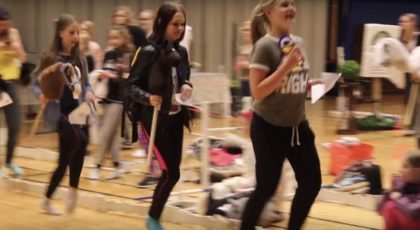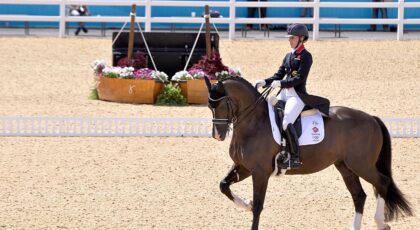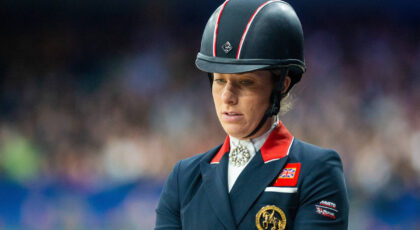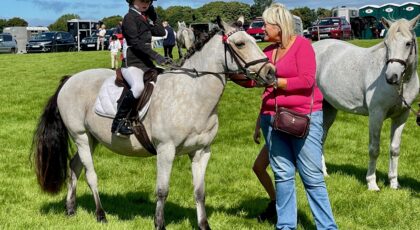My green warmblood True and I have started riding around a 275-acre ranch after our work in the arena is finished. It’s a nice way for him to cool out and do some trail-riding kindergarten at the same time.
On our first try, we sauntered around a 20- to 30-acre field where an arena is planned for the future. Sand for the new arena is already in place, and perhaps 500 yards away there are several stacks of steel fence panels and bucking chutes. The stacks are tall and solid, difficult to interpret from a distance even with human knowledge of this type of fencing.
True noticed the equipment right away, but we didn’t get close to it. He needs some calm easy walks in the general location first. We wandered around out there for 20 minutes or so on a loose rein.
The next day, we finished our arena work and headed out again.
No sooner had we left the barn and turned toward our mini-field than True screeched to a halt with ears pricked like razor blades and eyes like saucers. His head and neck raised another degree every couple seconds as we watched a scene that was completely still. No other horses or people were near us or out in the area we were riding to.
But overnight, the tall stacks of steel panels had been hauled to a new location, in preparation for installing the new arena fence. True seemed to observe the stacks with amazement, as if someone had moved Stonehenge by magic!
I encouraged True to step forward. After all, we were a thousand yards from the panels at this point. They were barely visible in the distance.
Very reluctantly, he obeyed and took perhaps five steps, then stopped again to raise his head for better depth perception. His eyes, ears, and nostrils opened wide, seeking information, trying to solve the mystery.
I wish I got it on camera, because this was a perfect demonstration of the horse/human difference in categorical perception.
Categorical perception is a human brain process, explained in Chapter 7 of Horse Brain, Human Brain. Our brains automatically experience items as members of groups. So when we see a big stack of fencing, our brains tell us that one important feature of fencing in general is that it cannot move by itself. Therefore, it must be the same stack of fencing even after it has been moved to a different location.
But horse brains don’t have categorical perception.
To the equine brain, each item in a new location is the equivalent of a brand new item. In other words, True’s brain would have assumed that the stacks in their initial location had disappeared, maybe packed up camp and migrated to better grazing elsewhere. And a new set of stacks had mushroomed up from underground all of a sudden in a different location.
Because prey brains demand rapid flight from hazardous new items, a horse is likely to shy from something she’s seen before just because it has moved or is being approached from a different angle. The fact that True did not see the move occur would only reinforce his belief that the relocated stacks were actually new and different objects, possibly hazardous.
I’ll keep you posted on our progress out in the big field. It will be interesting to learn True’s response when Stonehenge begins to separate, stand up, … and become an arena fence.
Related reading:
- The Perfect Flying Change
- Health Care for the Young Horse
- The Backward Step
- Hello, Mares! Preventing Misbehavior
Janet Jones will present “Brain to Brain: Cross-Species Communication between Horses and Riders” at the World Equestrian Center in Ocala, Florida, on March 14, 2024. Come to the talk and enjoy the international Winter Spectacular Hunter/Jumper Horse Show too. Learn more and reserve your tickets at https://janet-jones.com/product/janet-jones-ticket-sales.

A version of this story originally appeared on janet-jones.com. It is reprinted here with permission.




 March 13, 2024
March 13, 2024 




























